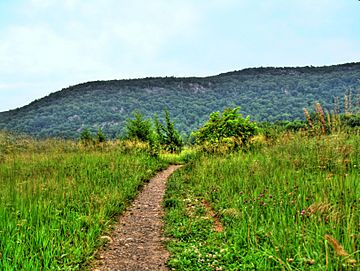Wawayanda Mountain facts for kids
Quick facts for kids Wawayanda Mountain |
|
|---|---|

Wawayanda Mountain from the Vernon Valley
|
|
| Highest point | |
| Elevation | 1,470 ft (450 m) |
| Geography | |
| Location | Sussex County, New Jersey, U.S. |
| Parent range | Appalachian Mountains |
Wawayanda Mountain is a cool ridge, which is like a long, narrow hill. You can find it in the Appalachian Mountains, specifically in the New York-New Jersey Highlands area. The very top of the mountain, called the summit, is located in Sussex County, New Jersey.
Contents
Exploring Wawayanda Mountain
Wawayanda Mountain covers a huge area, about 7,500 acres! That's like 5,700 football fields. Most of this land is covered in deciduous forest, which means trees that lose their leaves in the fall. There are also some areas with coniferous woods (trees like pines that stay green all year) and scrub-shrub plants.
This mountain, along with Pochuck Mountain to its west, helps form the edges of the Vernon Valley. This valley is a really important area in New Jersey, known for farming and mining. A creek called Pochuck Creek flows through and drains this valley.
Hiking the Appalachian Trail
If you love hiking, you'll be excited to know that the famous Appalachian Trail runs right over the top of Wawayanda Mountain! This part of the trail is inside Wawayanda State Park, which is a great place to explore nature.
How Wawayanda Mountain Was Formed
Wawayanda Mountain is part of a special geological area called the Reading Prong. This area is a section of the New England Uplands, which itself is part of the larger Appalachian Mountains.
The rocks that make up Wawayanda Mountain are very, very old. They are mostly metamorphic rocks, which means they were once other types of rocks that changed due to extreme heat and pressure deep inside the Earth. These ancient rocks are part of what geologists call the "Crystalline Appalachians."
The Crystalline Appalachians stretch a long way, from the Green Mountains in Vermont all the way down to the Blue Ridge Mountains in the south. They are different from other parts of the Appalachians, like the Kittatinny Mountains nearby, which are made of sedimentary rocks. Sedimentary rocks are formed from layers of sand, mud, and other materials that get pressed together over time.
Wildlife on the Mountain
Wawayanda Mountain is home to many different animals. Some of the larger Mammals you might see here include the black bear and the white-tailed deer. Remember to always keep a safe distance if you spot any wildlife!

